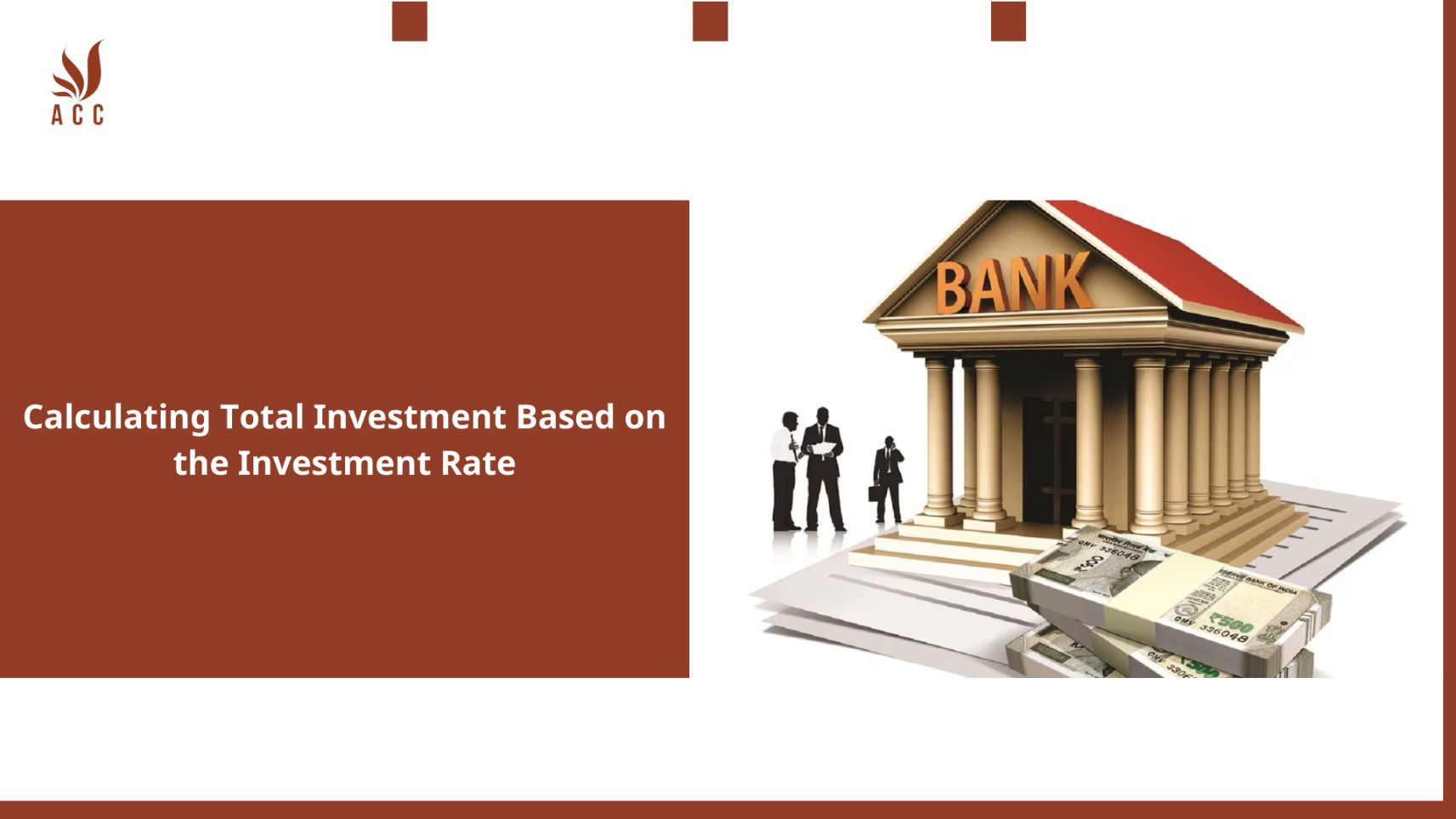
1. Calculating Total Investment Based on the Investment Rate
When it comes to making financial decisions, whether you're an individual or a business, one critical factor to consider is Return on Investment (ROI). ROI is a powerful performance measure used to assess the efficiency and profitability of an investment. In this article, we will unravel the concept of ROI, understand how to calculate it, explore its applications, and its limitations. So, let's dive into the world of ROI and discover how it can guide your financial choices.
2. What Is Return on Investment (ROI)?
Return on Investment (ROI) is a performance metric that evaluates the efficiency or profitability of an investment. It's like a measuring tape for your financial decisions. This metric aims to directly gauge the return on a particular investment relative to its cost. In simple terms, it tells you how much money you've made (or lost) on an investment after accounting for its cost.
To calculate ROI, you can use the following formula:
ROI = (Current Value of Investment - Cost of Investment) / Cost of Investment
"Current Value of Investment" refers to the proceeds obtained from the sale of the investment. ROI is expressed as a percentage, making it easy to compare with returns from other investments. This comparison allows you to evaluate different investment options and make informed decisions.
3. Why Is ROI a Useful Measurement?
ROI is a popular metric for a reason—it's versatile and straightforward. It acts as a basic indicator of an investment's profitability. Whether you're considering a stock investment, expanding a business, or engaging in a real estate transaction, ROI provides valuable insights.
The calculation itself is not overly complex, and its interpretation is relatively easy, making it suitable for a wide range of applications. If an investment's ROI is positive, it's usually a good sign. However, it's crucial to keep an eye out for opportunities with higher ROIs, as they might be more lucrative. On the flip side, negative ROIs indicate a net loss and are best avoided.
For example, let's say Jo invested $1,000 in Slice Pizza Corp. in 2017 and sold the shares for a total of $1,200 one year later. To calculate the ROI of this investment, we divide the net profits ($200) by the investment cost ($1,000), resulting in an ROI of 20%. This information allows us to compare the Slice Pizza investment with other options.
4. What Are the Limitations of ROI?
While ROI is a valuable tool, it's not without its limitations, as demonstrated by Jo's investments. Comparing investments can be tricky when they have different timeframes. Jo's second investment took three years to generate returns, while the first investment only took one year. To address this issue, we can adjust the ROI of the multi-year investment to obtain an average annual ROI.
For instance, with a total ROI of 40% over three years, Jo's annualized ROI would be approximately 13.33%. This adjustment reveals that, despite the second investment generating more profit, the first investment was more efficient in terms of annual returns.
ROI can be complemented by metrics like the rate of return (RoR), which considers the project's timeframe, and net present value (NPV), which accounts for the time value of money due to inflation. These metrics provide a more comprehensive view of the investment's performance.
5. What Are the Wider Applications of ROI?
In recent years, the concept of ROI has expanded into various specialized forms, such as social return on investment (SROI). SROI considers broader impacts of projects, including social and environmental factors not traditionally reflected in financial accounts. This form of ROI helps assess the societal and environmental value of projects, even when the traditional ROI might not immediately show a positive result.
Businesses and investors also use other niche ROI variations, such as social media statistics ROI, marketing statistics ROI, and learning ROI. These metrics focus on specific areas like social media campaign effectiveness, advertising returns, and the value of education and skills training.
As the world evolves and economies change, new ROI variants are likely to emerge, addressing the evolving needs of businesses and investors.
6. What Is ROI in Simple Terms?
In the simplest of terms, ROI answers a crucial question: How much money have you made (or lost) on an investment after considering its cost?
7. How Do You Calculate Return on Investment (ROI)?
ROI is calculated by dividing the profit earned on an investment by the cost of that investment. For example, an investment with a profit of $100 and a cost of $100 would have an ROI of 100%. While ROI is a quick and easy way to estimate an investment's success, it does have limitations. It doesn't account for the time value of money, and comparing ROIs between investments with different timeframes can be challenging. For these reasons, professional investors often use other metrics like net present value (NPV) or the internal rate of return (IRR) for more in-depth analysis.
8. What Is a Good ROI?
The definition of a "good" ROI varies depending on factors like an investor's risk tolerance and the time required for an investment to generate returns. More risk-averse investors may accept lower ROIs in exchange for safety. Investments with longer payback periods typically require higher ROIs to be attractive to investors.
9. What Industries Have the Highest ROI?
Historically, the average ROI for the S&P 500 has been around 10% per year. However, the ROI can significantly vary across industries. For instance, in 2020, many technology companies achieved annual returns well above 10%, while some industries like energy and utilities saw lower ROIs or even losses. The industry's average ROI changes over time due to factors like competition, technological advancements, and shifting consumer preferences.
10. The Bottom Line
Return on Investment is a versatile metric that assists investors in evaluating the profitability of investments and comparing various options. While it provides valuable insights, ROI has its limitations, such as not considering the timeframe, opportunity costs, or the impact of inflation on investment returns. Therefore, it's essential to use ROI in conjunction with other metrics to make well-informed financial decisions. So, whether you're an individual investor or a business leader, understanding and applying ROI can be a game-changer in your financial strategy.
11. Why should professionals use ACC Law Firm's capital Service?
-
Expertise in Legal Matters: ACC Law Firm specializes in providing legal services, which means they have a deep understanding of the legal intricacies and requirements associated with capital transactions. This expertise can be invaluable when dealing with complex financial and legal matters.
-
Customized Solutions: ACC Law Firm is likely to offer tailored solutions to meet the specific needs of professionals. Whether you are an individual or a business, their team can work closely with you to create a financial strategy that aligns with your goals and objectives.
-
Risk Management: Capital transactions often involve various risks, including legal and financial risks. ACC Law Firm can help professionals navigate these risks effectively, ensuring compliance with regulations and minimizing potential legal liabilities.
-
Regulatory Compliance: Professionals must adhere to various laws and regulations when raising capital or engaging in financial transactions. ACC Law Firm can provide guidance and ensure that all legal requirements are met, reducing the risk of legal disputes or penalties.
-
Legal Documentation: Capital transactions typically require extensive legal documentation, such as contracts, agreements, and prospectuses. ACC Law Firm's expertise can help professionals draft and review these documents to protect their interests and ensure accuracy.
Q&A
Question 1: How can you calculate the total investment based on the investment rate?
Answer 1: To calculate the total investment, multiply the initial principal amount (the amount you want to invest) by the investment rate expressed as a decimal. The formula is Total Investment = Initial Investment × Investment Rate.
Question 2: What is the investment rate, and how is it typically expressed?
Answer 2: The investment rate, often referred to as the annual interest rate or return on investment (ROI), is a percentage that represents the annual return or earnings on an investment. It is typically expressed as a percentage, such as 5% or 8%.
Question 3: Can you provide an example of calculating the total investment with an investment rate?
Answer 3: Sure. Let's say you want to invest $10,000 at an annual interest rate of 6%. To calculate the total investment after one year, you would use the formula: Total Investment = $10,000 × 0.06 (6% expressed as a decimal) = $600. So, your total investment after one year would be $10,600.
Question 4: What factors might impact the accuracy of the calculated total investment based on the investment rate?
Answer 4: The accuracy of the calculated total investment can be affected by factors such as changes in the investment rate over time, compounding (if applicable), fees, and other variables that may influence the actual returns on the investment. It's important to consider these factors when making investment calculations.
Nội dung bài viết:






Bình luận